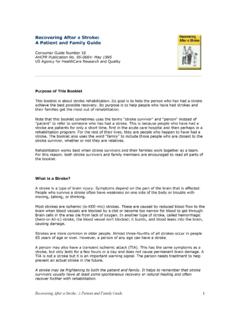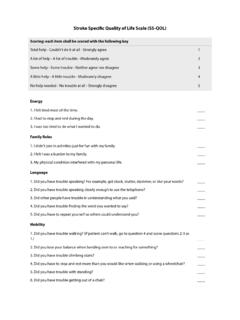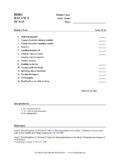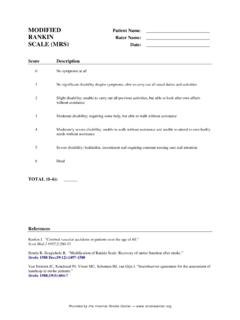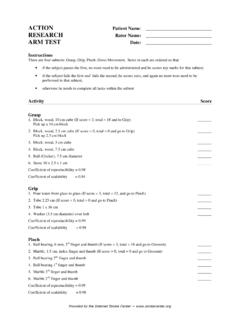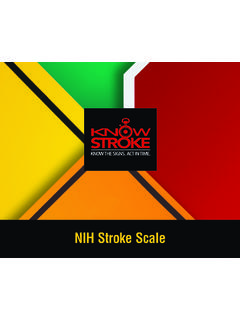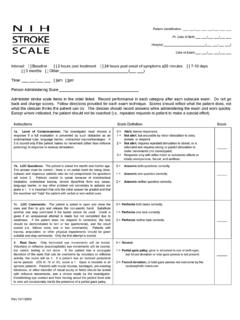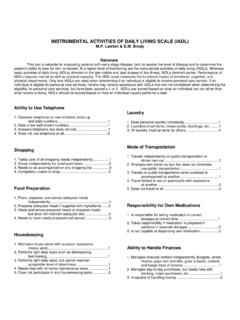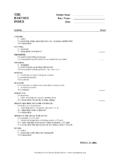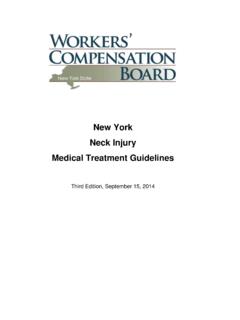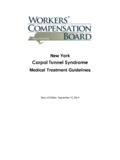Transcription of FUNCTIONAL EVALUATION: THE BARTHEL INDEX
1 Mahoney FI, BARTHEL D. FUNCTIONAL evaluation : The BARTHEL INDEX . Maryland State Medical Journal 1965;14:56-61. Used with permission. REHABILITATION NOTES REHABILITATION SECTION DOUGLAS G. CARROLL BALTIMORE CITY MEDICAL SOCIETY EDITOR FUNCTIONAL evaluation : THE BARTHEL INDEX A simple INDEX of independence useful in scoring improvement in the rehabilitation of the chronically ill ince 1955, the chronic disease hospitals in Maryland FLORENCE I. MAHONEY, (Montebello State Hospital, Deer's Head Hospital, and AND Western Maryland Hospital) have been using a simple INDEX DOROTHEA W.
2 BARTHEL , BA, PT of independence to score the ability of a patient with a neuro- muscular or musculoskeletal disorder to care for himself, and by repeating the test periodically, to assess his improvement. The INDEX (BI) has also been taught to many nurses, who have been helpful in evaluating patients prior to admission to these hospitals and after discharge. The values assigned to each item are based on time and amount of actual physical assistance required if a patient is unable to perform the activity.
3 Full credit is not given for an activity if the patient needs even minimal help and/or supervision, ie, if he cannot safely perform the activity without someone present in the room with him. Because of the time required to attend an incontinent patient and since he is not socially acceptable, continence was weighted heavily. Environmental conditions may affect the patient s score. If he has special requirements (other than the usual home setting), his score will be lower when they are not met. Examples are: doorways wide enough for easy access by wheelchair; all rooms on the same level if he cannot walk; grab bars at the toilet and tub.
4 To be more valuable, an explanation of special environmental requirements should accompany the BI of each patient when these are indicated. Each patient s BI is scored at the beginning of treatment in the Rehabilitation Service (PM&R), at intervals during the course of his rehabilitation, and at the time of maximum benefit. In this way, it is possible to determine how well and how rapidly he has progressed toward independence. Sometimes improvement does not show up because the presence of another person may still be required even though he does not actually give physical assistance.
5 Usually lack of improvement in the BI after a reasonable period of treatment indicates poor potential for rehabilitation. S Mahoney FI, BARTHEL D. FUNCTIONAL evaluation : The BARTHEL INDEX . Maryland State Medical Journal 1965;14:56-61. Used with permission. BARTHEL INDEX With Help Independent 1. Feeding (if food needs to be cut up = help) 5 10 2. Moving from wheelchair to bed and return (includes sitting up in bed) 5-10 15 3. Personal toilet (wash face, comb hair, shave, clean teeth) 0 5 4.
6 Getting on and off toilet (handling clothes, wipe, flush) 5 10 5. Bathing self 0 5 6. Walking on level surface (or if unable to walk, propel wheelchair) 0* 5* *score only if unable to walk 7. Ascend and descend stairs 5 10 8. Dressing (includes tying shoes, fastening fasteners) 5 10 9. Controlling bowels 5 10 10. Controlling bladder 5 10 A patient scoring 100 BI is continent, feeds himself, dresses himself, gets up out of bed and chairs, bathes himself, walks at least a block, and can ascend and descend stairs.
7 This does not mean that he is able to live alone: he may not be able to cook, keep house, and meet the public, but he is able to get along without attendant care. DEFINITION AND DISCUSSION OF SCORING 1. Feeding 10 = Independent. The patient can feed himself a meal from a tray or table when someone puts the food within his reach. He must put on an assistive device if this is needed, cut up the food, use salt and pepper, spread butter, etc. He must accomplish this in a reasonable time. 5 = Some help is necessary (with cutting up food, etc.)
8 , as listed above). 2. Moving from wheelchair to bed and return 15 = Independent in all phases of this activity. Patient can safely approach the bed in his wheelchair, lock brakes, lift footrests, move safely to bed, lie down, come to a sitting position on the side of the bed, change the position of the wheelchair, if necessary, to transfer back into it safely, and return to the wheelchair. 10 = Either some minimal help is needed in some step of this activity or the patient needs to be reminded or supervised for safety of one or more parts of this activity.
9 5 = Patient can come to a sitting position without the help of a second person but needs to be lifted out of bed, or if he transfers with a great deal of help. Mahoney FI, BARTHEL D. FUNCTIONAL evaluation : The BARTHEL INDEX . Maryland State Medical Journal 1965;14:56-61. Used with permission. 3. Doing personal toilet 5 = Patient can wash hands and face, comb hair, clean teeth, and shave. He may use any kind of razor but must put in blade or plug in razor without help as well as get it from drawer or cabinet.
10 Female patients must put on own makeup, if used, but need not braid or style hair. 4. Getting on and off toilet 10 = Patient is able to get on and off toilet, fasten and unfasten clothes, prevent soiling of clothes, and use toilet paper without help. He may use a wall bar or other stable object for support if needed. If it is necessary to use a bed pan instead of a toilet, he must be able to place it on a chair, empty it, and clean it. Patient needs help because of imbalance or in handling clothes or in using toilet paper.
